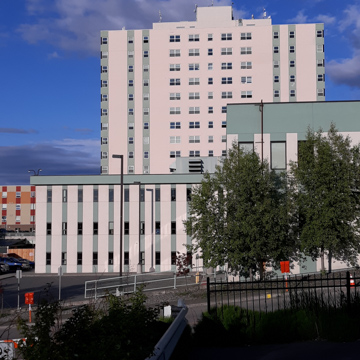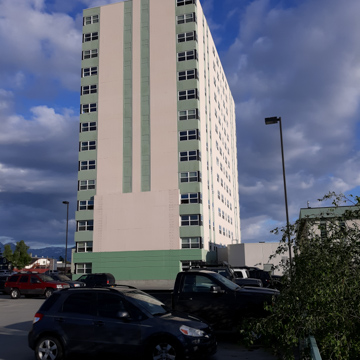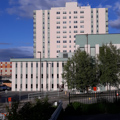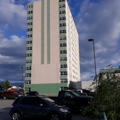You are here
McKinley Towers
McKinley Towers is a 14-story, 604 unit apartment building that sits on the eastern edge of Anchorage's downtown. It's locally infamous for its association with the suspicious death of Muriel Pfeil Jr., a member of one of Alaska's wealthiest families. Throughout most of the 1980s until 2006, the building was known as one of Anchorage’s most visible derelict structures. It reopened in 2006 as an apartment complex and remains a residential anchor of the northeast end of Anchorage's downtown.
The building was originally built in 1951, a partnership between a Seattle contracting firm and locals Al Swalling and Jack Clawson. Construction costs were $1.5 million, about $15 million in 2020. Its original name was the Mt. McKinley Building. The similar McKinley and Inlet Towers were both designed by Seattle architect Earl Morris in the style of early modernism. Although space was not at a premium in and around Anchorage, an influx of workers and soldiers arrived in need of housing after the war; the vertical towers provided a quick solution. Alaska had become a particularly strategic location in the emerging Cold War, and the military had invested heavily in the area's military installations. The building was one of the first series of high-rises built in Anchorage, a response to a severe housing shortage that transformed Anchorage from a minor railroad hub into the state’s demographic and economic center, one intimately tied to federal spending. Parking is accessible below the building and at street level. Though it was not advertised for its luxuries, the building was an affordable and updated place to live for those who arrived in the burgeoning town.
The building opened in 1952. In 1953, Channel 11, which evolved into local television station KTVA, began broadcasting from the first floor, consistent with the developer's expectation that some of the building might be used for commercial purposes. Just ten years after the first tenants moved in, the building experienced extensive damage during the 1964 earthquake, including a striking pattern of X-shaped cracks along the exterior walls. This forced out the tenants, and the owners soon could no longer afford the debt, resulting in the building’s repossession by its creditors. Local lawyer Neil Mackay bought the property cheaply at auction, renaming it after himself. However, he altered his surname from Mackay to MacKay (with a capitalized 'K') for the building, worried that people would otherwise mispronounce the name. The building was converted into office space except for the penthouse apartment occupied by Mackay.
In 1968, Mackay, a well-known lawyer and real-estate investor, married Muriel Pfeil Jr. of one of Anchorage’s wealthiest families. Her mother, Muriel Pfeil Sr., financed the addition of the three-story annex to the MacKay Building in 1969. Seven years later, amid a well-publicized and rancorous divorce between Mackay and Pfeil, Muriel Jr. was killed by a car bomb in downtown Anchorage, not far from the building and in the middle of the afternoon. Though never charged, Mackay was the only suspect, and speculation as to his guilt has never abated. Mackay was later charged but acquitted for the 1985 murder of Muriel Jr.’s brother, Bob Pfeil.
City officials condemned the MacKay Building in 1982 for failing to meet fire safety codes. Said Mackey, “If God couldn't shake that building down, how can it burn down? It's concrete and steel. What's gonna burn?” He sold the building in 1984, but any hopes for a renovation died with Alaska’s late 1980s economic collapse. The building was repossessed again, this time by a savings and loan. From 1983 through 2006, the building was an vacant eyesore, sitting on downtown's eastern edge. In 1999, developer Marc Marlow bought the property with the incentive of a five-year exemption from property taxes. In order to renovate the building, Schneider Structural Engineers performed a seismic evaluation. To upgrade the building, they installed fiber-reinforced polymer (FRP) fabrics, a material with strength that is comparable to steel. This creative retrofit and effectively brought the building up to code and ensure its status worthy of preservation as the city’s first high-rise. In 2006, it reopened as McKinley Tower Apartments, reconverted as apartments. The structure was added to the National Register of Historic Places in 2008.
References
Brennan, Tom. Cold Crime: How Police Detectives Solved Alaska’s Most Shocking Cases. Kenmore, WA: Epicenter Press, 2005.
Bryson, George. “No More Marlow Manor.” Anchorage Daily News, December 15, 2008, A1.
Pulliam, Elizabeth. “Waiting for the Wrecker.” Anchorage Daily News, October 26, 1989, F1.
Rogers, Barbara. “Police Probe Bomb Death.” Anchorage Times, November 1, 1976, 1, 2.
Shinohara, Rosemary. “McKinley Redux—Former Downtown Eyesore Opens.” Anchorage Daily News, August 3, 2006, B1.
Toomey, Sheila. “Fairbanks Jury Finds Mackay Not Guilty.” Anchorage Daily News, February 8, 1988, A1.
Turner, Wallace. “Alaskan Murder: Enigma Within an Enigma.” New York Times, June 20, 1987, A23.
Writing Credits
If SAH Archipedia has been useful to you, please consider supporting it.
SAH Archipedia tells the story of the United States through its buildings, landscapes, and cities. This freely available resource empowers the public with authoritative knowledge that deepens their understanding and appreciation of the built environment. But the Society of Architectural Historians, which created SAH Archipedia with University of Virginia Press, needs your support to maintain the high-caliber research, writing, photography, cartography, editing, design, and programming that make SAH Archipedia a trusted online resource available to all who value the history of place, heritage tourism, and learning.

















